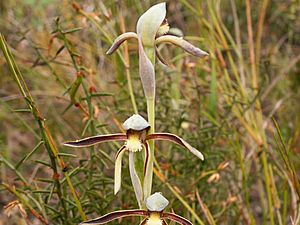Rattle beaks facts for kids
Quick facts for kids Rattle beaks |
|
|---|---|
 |
|
| Rattle beaks growing near Albany | |
| Scientific classification | |
| Synonyms | |
|
Caladenia serrata Lindl. Rchb.f. |
The Lyperanthus serratus, often called rattle beaks, is a special type of orchid. It grows only in the south-west part of Western Australia. This plant gets its fun name because its flowers make a rattling sound if you gently shake them. It's like a tiny natural maraca!
Contents
What Does the Rattle Beaks Orchid Look Like?
The rattle beaks orchid is a plant that grows from a tuber (like a small underground storage part). It comes back every year. These plants usually grow to be about 25 to 50 centimeters (10 to 20 inches) tall.
Flowers of the Rattle Beaks Orchid
The orchid has between 3 and 10 flowers. They are a mix of green, yellow, and brown colors. Each flower is about 3 to 5 centimeters (1 to 2 inches) wide. You can see these unique flowers from September to October. The flowers have tiny white hairs on their labellum, which is the special lip-like part of the orchid flower.
Leaves of the Rattle Beaks Orchid
Each rattle beaks plant has only one leaf. This leaf is long and curved, like an arch. It feels tough and has visible lines or ribs. The leaf can be up to 35 centimeters (14 inches) long and about 1.5 centimeters (0.6 inches) wide. The whole plant, except for the very inside parts of the flower, is covered in a powdery, dusty layer. The leaf is shaped like a spearhead. It is dark green on top and a lighter green underneath.
How Did the Rattle Beaks Orchid Get Its Name?
The rattle beaks orchid was first officially described in 1840. A scientist named John Lindley gave it its scientific name, Lyperanthus serratus. He wrote about it in his book, The Genera and Species of Orchidaceous Plants.
The Meaning Behind the Name
The second part of its scientific name, serratus, means "saw-toothed." This name comes from the tiny white bumps found on the edge of the flower's labellum. These bumps look a bit like the teeth on a saw.
Where Does the Rattle Beaks Orchid Grow?
This orchid lives in several different areas of Western Australia. These areas include the Avon Wheatbelt, Esperance Plains, Jarrah Forest, Swan Coastal Plain, and Warren regions. It can grow in different types of soil, like sand, loam (a mix of sand, silt, and clay), or sandy clay.
Rattle Beaks Orchid's Favorite Homes
You can find the rattle beaks orchid in many places. It grows in forests, woodlands, and areas with low, shrubby plants called heathlands. It often likes to grow among other plants that are not too tall but are quite thick.
Can You Grow Rattle Beaks Orchids at Home?
Growing Australian ground orchids, like the rattle beaks, can be a bit tricky. They are not very common in home gardens. However, some people have had success growing a similar orchid called Lyperanthus suaveolens. This suggests that with the right care, rattle beaks might also be grown by plant lovers.

